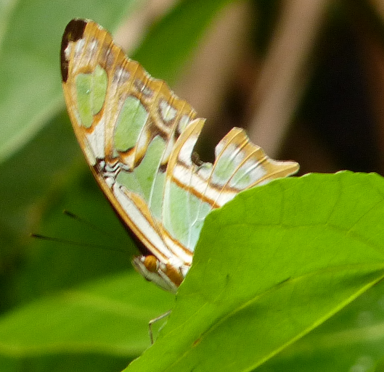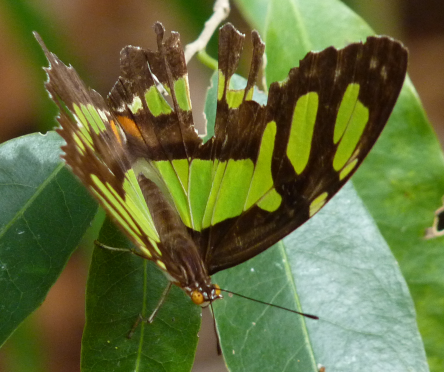

Photo and Video at Punta Cana
BIRD
Greater Antillean Grackle (Quiscalus niger) Hispaniola subspecies: Q.n. niger
Photo: <1> (iris color: adults of both sexes are yellow while immatures are light brown) <2> ; tail-less & broken leg - <1>
In North American grackles, the tail feathers are shed synchronously, typical when the outer primaries are being molted (their prebasic molts occur on breeding grounds, before the onset of winter or migration.). Flocks of "tail-less" grackles flying around are thus a common sight in late summer and fall. Steve Howell's book on Molt p.235
"August 26: Adult male Boat-tails have now shed all their tail feathers and are in very ragged moult ( 衣衫襤褸的換毛 )." src
Little Blue Heron
Photo: adult - fish is yummy (Can you find the fish?) <0> <1> <2> <3> <4> <5>
juvenile - <1>
Yellow Crowned Night Heron
Photo:
fly away (zoom-in)
Video:
- <1>
Spotted Sandpiper
Common Ground-dove
Yellow-faced Grassquit
Photo: <1>
Smooth-billed Ani
Photo: <1>
Village Weaver
Photo: hanging nest
Hispaniola Woodpecker
Photo:
<1>
injured juvenile
- <1>
Video:
- adults & a helpless juvenile (4/7
Thu)
Hispaniola Lizard Cuckoo
Photo: <1>
Palmchat
Gray Kingbird
Photo: <1>
Loggerhead Kingbird
Photo: food for girl <2> (cf. this found on Web)
Antillean Mango (Anthracothorax dominicus) 安的列斯 芒果 蜂鳥 / 黑胸芒果蜂鸟
Photo: outside our room - <1> (probably a female)
Black-throated Mango (Anthracothorax nigricollis, 黑喉芒果蜂鸟) is a similar one found on Trinidad and Tobago. 由于 Trinidad 多蜂鸟,素称"蜂鸟之乡" (Land of the Hummingbird)。 蜂鸟也是该国的国鸟。其国徽中心图案为盾徽。盾面上部为黑地上两只蜂鸟,象征着这个人口只有120万的国家不畏强权、酷爱独立和自由的精神。 src
Info: p.135 p.136 info in chinese Photo found on Web - male mirror ; female front mirror ; female back mirror ; female mirror ; mother feeding young? mirror
Birds of Peru (2007) By Thomas S. Schulenberg : p.217 p.218 p.219
Vervain Hummingbird (Mellisuga minima)
Photo found on Web - <1>
Black crowned Palm Tanager & Red Legged Thrush - Video: <1>
Unknown birds
Photo: (1) a juvenile (Mourning Dove or Zenaida?) <1> <2> <3> compared with found on Web: Ring Neck Turtle Dove Juvenile Nestling Mourning Dove 1 ( mirror: Late nestling Mourning Dove , Fledgling Mourning Dove ) Adult with fledgling Mourning Dove Mourning Dove parent with two chicks in Mesa, Arizona
(2)
at Fruit Garden (Jardin Frutal) <1> (Black-whiskered
Vireo?)
One Black-whiskered Vireo nest found in Florida was composed of carpet fibers and duck feathers, and was suspended by nylon fishing line.
src
OTHERS
Land Hermit Crab (Caribbean Hermit Crab, Coenobita clypeatus; also known as Soldier Crab, Tree Crab, & Purple Pincher (due to the distinctive purple claw)
Other Crabs
Lizard incl. Anole (Green, Bark? & Brown?)
Photo: 1. Brown
Anole? - close up of head
<1> <2>
<3> ;
<4>
2.
Hispaniolan Green Anole (not an adult male, probably an adult female) - <1>
* saw many of them repeatedly protracting and retracting its
dewlap (or throat fan, 垂肉,垂皮,頸袋) & doing
"pushups."
Video:
Male Anole doing pushups
and dewlap display
Anole with a purple-blue head
Hispaniolan Green Anole (Anolis
chlorocyanus) - an adult female (or juvenile?)
Anole in brown color
Bark Anole is so named due to its extraordinary ability to
blend into the bark of whichever tree it happens to be resting upon.
Anolis scriptus is an endemic species known only to the southern Bahamas
and Turks & Caicos.
[1]
The
North American species Green Anole (Anolis carolinensis 綠變色蜥 / 綠樹蜥 / 綠安祿蜥 / 綠變色龍) has recently become the first
reptile to have its complete genome sequenced.
[2]
Mating picture found on Web
The Hispaniolan Green
Anole (Anolis chlorocyanus) is a species of anole native to the
island of Hispaniola. Photo found on Web:
adult
female
adult
male
juvenile
Anolis distichus
(Bark Anole)
Polychrotidae:
commonly known as anoles. Anole lizards are frequently and
incorrectly called American
chameleons
or geckos (壁虎 :
垂直型瞳孔; 体通常为暗黄灰色,带灰、褐、浊白斑;但产於马达加斯加岛的日行壁虎属(Phelsuma),却含鲜绿色型,且白天活动。
src),
although they are not closely related to either of those groups. In fact, they
are more closely related to
iguanas. These misconceptions are likely due to their ability to alter their
skin color and run up walls.
Brown Anole (Anolis sagrei)
also called the Cuban Anole. Females have diamond-shaped patterns down
back; males may display patterns, but never diamond shapes; dewlaps are red to
red-orange with a yellow border. Male Brown Anoles will also display dewlap and
do pushups when approached by people.
Males of both Green and Brown Anoles also do "pushups" as threat gestures
and when competing with other males for territory or females; the pushups
combined with the dewlap display and roach down the back make the male anole
look larger (size does count in threat displays).
http://www.corkscrew.audubon.org/wildlife/lizards.html
http://www.floridiannature.com/Anoles.htm : Florida Bark Anole, Cuban Brown
Anole, North American species Green Anole, & Knight Anole.
Photo found on Web:
http://www.ribbitphotography.com/galleries/anoles/index.html
Anolis fowleri, a rare Anole from Dominican Republic.
香港仔郊野公園 影 變色樹蜥 食 麗眼斑螳
及 鐵線蟲 出現
Spider
Photo: Female Nephila clavipes - <1> <2> ; another - <3>
my spider note : Nephila clavipes has an abdomen whose dorsal (upper) surface is marked with a multitude of white or pale yellow spots on a gold background.
Termites
Photo: <1>
All termites eat cellulose in its various forms as plant fibre. Cellulose is a rich energy source (as demonstrated by the amount of energy released when wood is burned), but remains difficult to digest. Termites rely primarily upon symbiotic protozoa (metamonads) such as Trichonympha, and other microbes in their gut to digest the cellulose for them and absorb the end products for their own use. Gut protozoa, such as Trichonympha, in turn rely on symbiotic bacteria embedded on their surfaces to produce some of the necessary digestive enzymes. This relationship is one of the finest examples of mutualism among animals. Most so-called higher termites, especially in the Family Termitidae, can produce their own cellulase enzymes. However, they still retain a rich gut fauna and primarily rely upon the bacteria.
In the colony, only the workers can digest wood.
Termites share food with others. Furthermore, termites share not only share liquid to communicate, but they share liquid that contains organisms to digest their food. In addition to these modes of transmission, termites eat other dead termites. They also eat back their feces. The organisms are transferred to each other through their fecal matter. Newly hatched termites are first inoculated with these indispensable protozoans by eating the feces of their older brothers and sisters. src: [1] [2]
A better one found on Web: Due to evolution, termites began to produce a bodily fluid containing the microorganisms known as protozoa millions of years ago. Termites excrete this liquid when they defecate. After being born, the termite larvae consume the adult termites' feces and they, in turn, ingest the protozoa which then live inside their digestive systems. When termites molt, shedding their exoskeleton in order to grow, they lose the protozoa within their digestive system. To get more protozoa, which they need to survive, the termites ingest the feces of another termite, thereby reintroducing protozoa to their bodies to aid in digestion. Read more: How Do Termites Digest Wood? | eHow.com
Wasp
Photo: <1>
Butterfly/moth
Photo:
<1>
<2>
<3>
Malachite (cf.
here
mirror) :
M1 under
M2 upper (The malachite has
large wings that are black and brilliant green or yellow-green on the uppersides
and light brown and
olive green on the undersides.)
Dragonfly & like
Photo:
<1> <2> (a
tiny dragonfly, Amberwing?)
; Probably Red Saddlebags (Tramea onusta) Skimmer Dragonfly
(look similar to Carolina Saddlebags which
is also a Skimmer.)
Photo found on Web:
Red Saddlebags, Florida
Red
Saddlebags, female
Striped
Saddlebags
A Guide to Their Identifiation
by Förster, Steffen
2001
ISBN: 3980436616
Fly & like
Photo:
Tachinid? (with black and gray
longitudinal stripes on the thorax
BUT NO checkering on the abdomen;
apex of abdomen is red; like some flies in family
Tachinidae (parasitic flies), family
Sarcophagidae (flesh
flies) or family
Calliphoridae (blow flies))
Note: (1) Hineomyia setigera is one of several NE tachinids (in North
America) in which the apex of the abdomen is bright red. (2) Many
tachinids are similar in general appearance to muscids (family
Muscidae) and
flesh flies; many are large, bristly, and beelike or wasp-like in appearance.
Presence of a subscutellum is a useful character.
src (3) Tachinid
flies including Zygostrumia and Winthemia species, belong to a large family of
parasitic flies. These flies are hairy and resemble house flies, but some
species are slightly larger. The tip of the abdomen may be red.
src
(has an image) (4)
The biology of the Muscidae of the world (1985) By Peter Skidmore
Turtle (Testudines) [sideNote: 7/3/2010 pm Diamondback terrapin ( 菱斑龜/鑽紋龜 ) program; also 6/6/2009 (Sat) links]
Photo: close up of head <1>
Fish
Photo: <1>